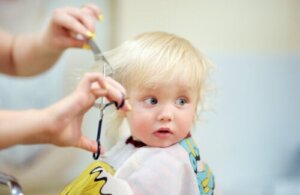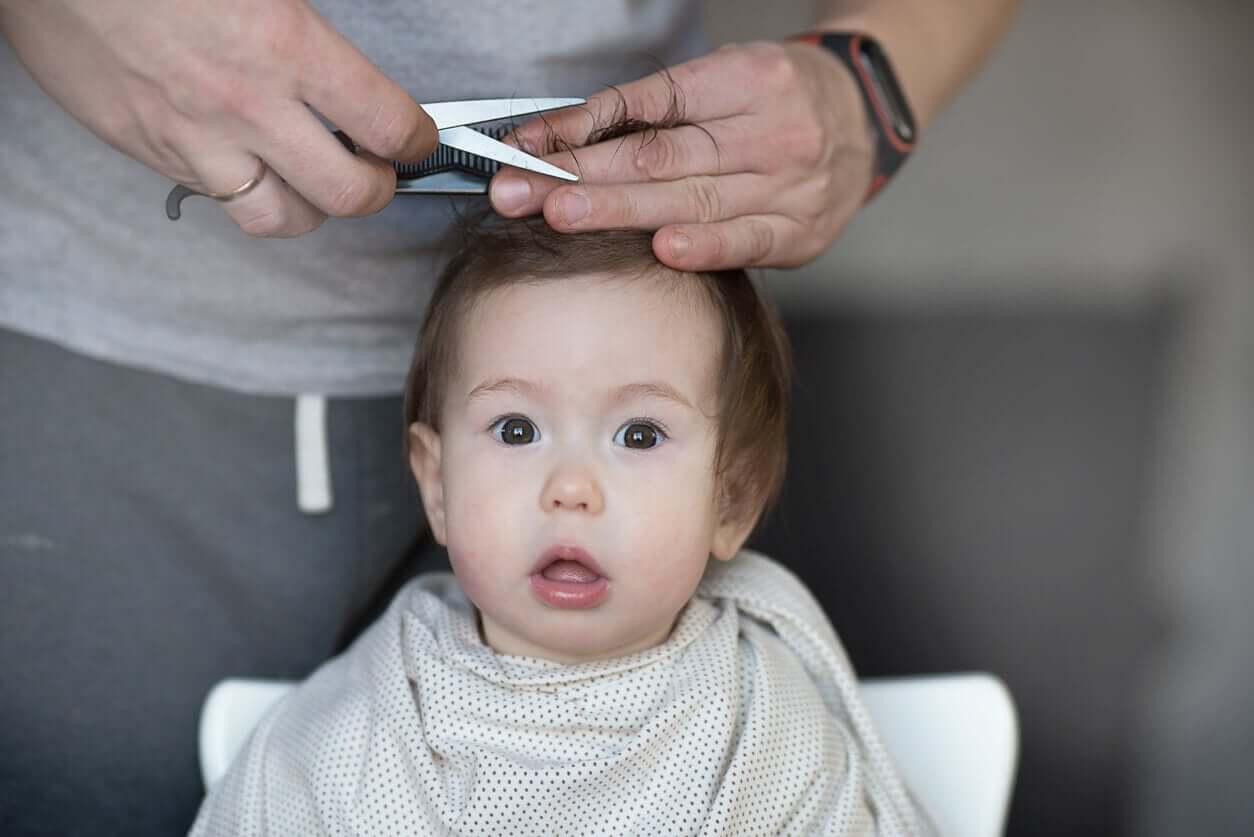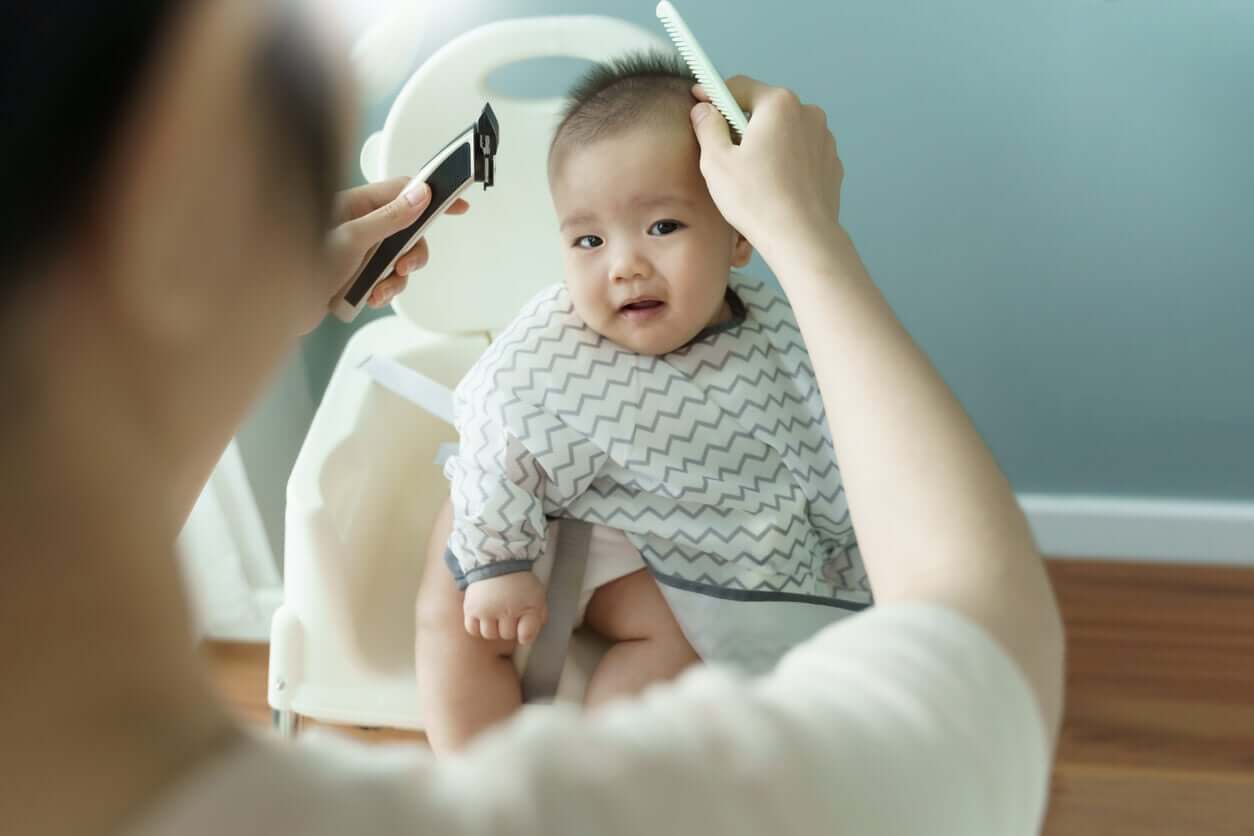How to Cut Your Baby's Hair?


Written and verified by the dermatologist Maria del Carmen Hernandez
Cutting your baby’s hair can be a daunting challenge. Even so, with the proper technique, it’s possible to make the experience a little more enjoyable and promote the habit. Do you want to know how? If so, keep reading!
When should you cut your baby’s hair for the first time?
Newborn hair is fine and fragile and tends to shed only during the first weeks of life. For this reason, it’s best to wait at least 3 months before cutting your baby’s hair for the first time.
In general, parents are eager to experience all of their child’s milestones. However, there’s no need to rush to take your little one to the hairdresser, as much of the hair they’re born with will fall out on its own.
The recommendation to wait a few weeks is based on the fact that the baby’s head is the main place where it loses heat. So, the hair protects it from the cold, especially in the winter months.
In addition, cutting hair doesn’t help it grow faster or stronger, despite popular myths.
Therefore, we should clarify that there’s no ideal time to cut your baby’s hair. This choice will be subject to the decision of the parents, based on your wishes and common sense.
The steps to cutting your baby’s hair
In general, babies are born with an abundance of fine hair on their bodies and heads, called lanugo. This hair fulfills essential protective functions and, when it’s no longer needed, it spontaneously falls out.
Now, when you decide to give your baby their first haircut, it’s good to take into account some tips.
1. Gather all the elements
Having all your supplies ready is one of the most important aspects of making the experience successful and avoiding interruptions.
So, with that in mind, you need to have the following elements:
- A towel
- A comb
- A scissors or machine for cutting hair
- A cloth or cape to cover your baby
- A seat for the baby (either tied in his chair or in the arms of a third party)
- A spray bottle of water
- A bag or container to collect the hair, in case you want to keep it as a memento
In addition, it is very useful to have some toys or the baby’s pacifier on hand to keep him distracted.
You may be interested:10 Skincare Tips for Babies and Children
2. Choose the right time
It’s important to choose the time of day when your baby’s most awake, in a good mood, and with all their needs satisfied. That is, they must be changed, fed, well-rested, and eager to do a new activity.
This will have a very positive influence on the task because, with the calm baby, the movement caused by irritability or crying is limited.
In part, the recommendation to wait until 3 months of age to cut your baby’s hair for the first time has to do with their neurological development. By this age, most children are able to support their heads on their own. And this is definitely a key element during the process.
3. Make it a fun activity
Babies respond to the body language of the people around them. Therefore, if the parents are happy when it comes to cutting their child’s hair, it’s more likely that the child will be, too. Singing songs in a happy voice can be a great way to make the task more enjoyable for everyone.
Also, it’s important to keep them entertained with something that grabs their attention. Giving them a second comb to play with is a very wise option.
4. Spray and cut your baby’s hair carefully
Before cutting with scissors, you need to slightly moisten the baby’s hair and slowly brush a small section of it.
Then, select a strand between your fingers and cut above them, never below them. In this way, the fingers function as shock absorbers, and possible accidents are avoided.
Diagonal and small sectional cuts are easier to blend between straight and long ones. At the same time, you have to take into account that the hair seems longer when it is wet.

Another way to cut your baby’s hair is with the clipper, but you have to be very careful and delicate.
Also read: Hair Loss in Newborns: Causes and Treatment
Recommendations for cutting your baby’s hair
Although cutting your baby’s hair doesn’t involve great risk, you need to take certain precautions to avoid injuries:
- Hold the head firmly to prevent sudden and unexpected movements. With this in mind, the help of another person may be necessary.
- Don’t leave the hair clipper or scissors within your baby’s reach.
- Avoid using razors or blades to cut hair.
- If the child has a cradle cap, try to remove it with almond oil and massage before the haircut. Under no circumstances should it be pulled off with your fingernails, because you can inadvertently damage your child’s scalp.
Is it necessary to cut your baby’s hair?
Cutting your baby’s hair is a matter of aesthetics and comfort. There’s no need to do it, nor is there a reason not to. And, in the same way, there’s no predetermined age for carrying it out.
If you decide to do it at home, it’s important to take extreme security measures in order to prevent unnecessary complications.
So, if you’re up for it, go ahead and give your baby their first haircut! And don’t forget to take pictures!
Cutting your baby’s hair can be a daunting challenge. Even so, with the proper technique, it’s possible to make the experience a little more enjoyable and promote the habit. Do you want to know how? If so, keep reading!
When should you cut your baby’s hair for the first time?
Newborn hair is fine and fragile and tends to shed only during the first weeks of life. For this reason, it’s best to wait at least 3 months before cutting your baby’s hair for the first time.
In general, parents are eager to experience all of their child’s milestones. However, there’s no need to rush to take your little one to the hairdresser, as much of the hair they’re born with will fall out on its own.
The recommendation to wait a few weeks is based on the fact that the baby’s head is the main place where it loses heat. So, the hair protects it from the cold, especially in the winter months.
In addition, cutting hair doesn’t help it grow faster or stronger, despite popular myths.
Therefore, we should clarify that there’s no ideal time to cut your baby’s hair. This choice will be subject to the decision of the parents, based on your wishes and common sense.
The steps to cutting your baby’s hair
In general, babies are born with an abundance of fine hair on their bodies and heads, called lanugo. This hair fulfills essential protective functions and, when it’s no longer needed, it spontaneously falls out.
Now, when you decide to give your baby their first haircut, it’s good to take into account some tips.
1. Gather all the elements
Having all your supplies ready is one of the most important aspects of making the experience successful and avoiding interruptions.
So, with that in mind, you need to have the following elements:
- A towel
- A comb
- A scissors or machine for cutting hair
- A cloth or cape to cover your baby
- A seat for the baby (either tied in his chair or in the arms of a third party)
- A spray bottle of water
- A bag or container to collect the hair, in case you want to keep it as a memento
In addition, it is very useful to have some toys or the baby’s pacifier on hand to keep him distracted.
You may be interested:10 Skincare Tips for Babies and Children
2. Choose the right time
It’s important to choose the time of day when your baby’s most awake, in a good mood, and with all their needs satisfied. That is, they must be changed, fed, well-rested, and eager to do a new activity.
This will have a very positive influence on the task because, with the calm baby, the movement caused by irritability or crying is limited.
In part, the recommendation to wait until 3 months of age to cut your baby’s hair for the first time has to do with their neurological development. By this age, most children are able to support their heads on their own. And this is definitely a key element during the process.
3. Make it a fun activity
Babies respond to the body language of the people around them. Therefore, if the parents are happy when it comes to cutting their child’s hair, it’s more likely that the child will be, too. Singing songs in a happy voice can be a great way to make the task more enjoyable for everyone.
Also, it’s important to keep them entertained with something that grabs their attention. Giving them a second comb to play with is a very wise option.
4. Spray and cut your baby’s hair carefully
Before cutting with scissors, you need to slightly moisten the baby’s hair and slowly brush a small section of it.
Then, select a strand between your fingers and cut above them, never below them. In this way, the fingers function as shock absorbers, and possible accidents are avoided.
Diagonal and small sectional cuts are easier to blend between straight and long ones. At the same time, you have to take into account that the hair seems longer when it is wet.

Another way to cut your baby’s hair is with the clipper, but you have to be very careful and delicate.
Also read: Hair Loss in Newborns: Causes and Treatment
Recommendations for cutting your baby’s hair
Although cutting your baby’s hair doesn’t involve great risk, you need to take certain precautions to avoid injuries:
- Hold the head firmly to prevent sudden and unexpected movements. With this in mind, the help of another person may be necessary.
- Don’t leave the hair clipper or scissors within your baby’s reach.
- Avoid using razors or blades to cut hair.
- If the child has a cradle cap, try to remove it with almond oil and massage before the haircut. Under no circumstances should it be pulled off with your fingernails, because you can inadvertently damage your child’s scalp.
Is it necessary to cut your baby’s hair?
Cutting your baby’s hair is a matter of aesthetics and comfort. There’s no need to do it, nor is there a reason not to. And, in the same way, there’s no predetermined age for carrying it out.
If you decide to do it at home, it’s important to take extreme security measures in order to prevent unnecessary complications.
So, if you’re up for it, go ahead and give your baby their first haircut! And don’t forget to take pictures!
All cited sources were thoroughly reviewed by our team to ensure their quality, reliability, currency, and validity. The bibliography of this article was considered reliable and of academic or scientific accuracy.
- Verhave BL, Nassereddin A, Lappin SL. Embryology, Lanugo. 2021 May 8. In: StatPearls [Internet]. Treasure Island (FL): StatPearls Publishing; 2021 Jan–. PMID: 30252348.
- Janniger CK, Bryngil JM. Hair in infancy and childhood. Cutis. 1993 May;51(5):336-8. PMID: 8513685.
- Neri I, Piccolo V, Cocchi G, Starace M, Patrizi A, Dika E, Piraccini BM. Hair in newborns and infants: clinical and dermoscopic evaluation of 45 cases. Br J Dermatol. 2013 Oct;169(4):896-900. doi: 10.1111/bjd.12459. PMID: 23746094.
- García Pérez MA, Martínez Granero MA. Desarrollo piscomotor y signos de alarma. En: AEPap (ed.). Curso
de Actualización Pediatría 2016. Madrid: Lúa Ediciones 3.0; 2016. p. 81-93. Disponible en: https://www.aepap.org/sites/default/files/2em.1_desarrollo_psicomotor_y_signos_de_alarma.pdf
This text is provided for informational purposes only and does not replace consultation with a professional. If in doubt, consult your specialist.









